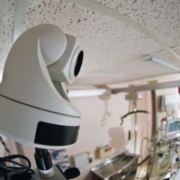In a single academic medical center study, implementation of a teleICU intervention was associated with reduced adjusted odds of mortality and reduced hospital length of stay, as well as with changes in best practice adherence and lower rates of preventable complications
Tele-ICU improves patient safety, mortality and length of stay. This effect is enhanced by continuous and proactive monitoring over episodic involvement, frequent performance reviews as well as close integration of the tele-ICU team with existing bedside team structures. Tele-ICU with added logistics functions has the potential to optimize ICU bed utilization and enhance financial performance
A tele-intensive care unit (tele-ICU) uses telemedicine in an intensive care unit (ICU) setting, applying technology to provide care to critically ill patients by off-site clinical resources… Intensivists working these systems are able to more effectively treat ICU patients, providing better clinical outcomes for patients at lower costs compared with hospitals without a tele-ICU
…an increasing number of studies have shown that intensivist-staffed intensive care units (ICUs) lead to overall economic benefits and improved patient outcomes, including shorter length of stay and lower rates of complications and mortality… This article explores the history of intensivists and critical care, the arguments for 24/7 ICU staffing, and outcomes in various ICU settings
After adjusting for demographics, illness severity, admission diagnosis, and facility, ICU telemedicine was associated with overall reduced transfers … this reduction occurred in patients with moderate, moderate to high, and high illness severity and in nonsurgical patients. Transfers decreased in patients admitted with GI and respiratory admission diagnoses..
The addition of a supplemental, telemedicine-based, remote intensivist program was associated with improved clinical outcomes and hospital financial performance… telemedicine may provide a means for hospitals to achieve quality improvements associated with intensivist care using fewer intensivists.
In the absence of a defined insurer reimbursement model for care delivery, revenue sources for a tele-ICU system depend entirely on the organizational structure of the system/network and variable contractual relationships between entities. A few different revenue models appear to currently exist.
Formal ICU telemedicine programs now support 11% of non-federal hospital critically ill adult patients. There is increasingly robust evidence of association with lower ICU and hospital mortality and shorter ICU and hospital length of stay. Early studies suggest that implementation of ICU telemedicine programs has been associated with lower numbers of malpractice claims and costs
The purpose of the tele-ICU is not to replace bedside clinicians or bedside care, but to provide improved safety and to enhance outcomes through standardization. The tele-ICU is a “second set of eyes” that provides additional clinical surveillance and support










